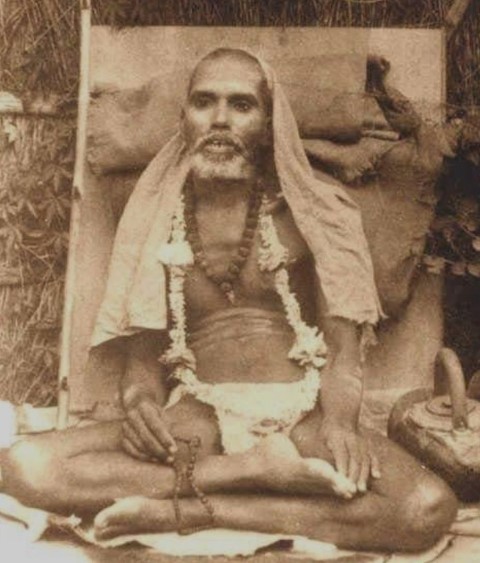|
In the very orthodox Shree Datta Cult, following among the order of Shree Shreepadvallabh, Shree Nrusinhsaraswati, Shree Narayanswami, Shree Govindswami, the most respectably mentioned and included name is Shree Vasudevanand Saraswati (Tembe) Swami Maharaj. “Vasudeva” alias Paramhansa Parivrajakacharya Vasudevanand Swami was born on Sunday, the 23th August 1854 - Shravan Krishna Panchami of 1776 as per Hindu calendar - at the village Mangaon of Sawantwadi Sansthan in Konkan, in the family of Shri.Ganeshbhat Tembe and Sau. Ramabai. His thread wearing ceremony was conducted at the age of eight years. After this ceremony he dedicatedly performed daily worshiping practices like bathing and pursuing rituals at three times of a day, homage to Deities of Fire, routine reading of Guru Charitra - The Biography of Guru, getting alms and offerings to Vaishvadeva, and then to have lunch. He resumed the studies of Vedas, Yajnik (Fire worshiping modes), studies of Sanskrit language, reading horoscopes and Yoga along with it.
Old Photograph of Tembe Swami Maharaj Due to strict observation of keeping vows, fasting, his body and mind had attained a very pious state. This benefited him for entering into the inner core of Yoga practicing and achieving supreme knowledge of everything. At Mangaon, everybody became aware of his intellect and proficiency in the Holy Scriptures. Vasudev Shastri got married to “Bayo” a daughter of a Constable Babajirao Gode of Ranganagad. According to scriptures, Vasudev Shastri after his marriage, started performing Pahchyagnya, daily Panchayatan worshiping and Smartagni. He also performed Gayatri Purascharan (chanting mantra for specific number and days). Once according to allegorical dream that he had, he went to Wadi and was benefited with initiation in Shree Datta tradition along with incantation (wise counsel) from a spiritual master, an ascetic, Shree Govinda Swami. An idol of Shree Dattatreya, brought from Kagal was installed at Mangaon by Shree Vasudev Shastri (on Vaishakh Shuddh Panchami, 1803). Shree Dattaguru bestowed many favors beyond one’s imagination, here at this place for seven years. Thereafter, abiding by directions given By Lord Dattatreya, he went to Narsobachi Wadi along with his wife. From Wadi, he was instructed to “travel northward” and reached Gangakhed on the banks of river Godavari, of District Parbhani, after visiting places pilgrimage of Kolhpur, Audumbar, Pandharpur, Barshi. At this very place, Annapurnabai - wife of Vasudev Shastri, left this earthly world, biding her final bow at the feet of husband, on Friday, the Chaturdashi (14th day) in the month of Vaishakh, 1813. On the very 14th day of her demise, Vasudev Shastri became an ascetic. He received ‘Danda’ from Shri Narayananand Saraswati Swami at Ujjain. By adopting to traditional practices with devotion in Karma - Bhakti - Yoga - Jnana (Duty - Devotion - Yoga - Knowledge) and attaining the utmost mastery in every traditional path of penance, he guided many sincere seekers and devotees. He dedicated his complete life in propagating the devotion of Lord Dattatreya and social welfare. He lived a strictly adherent ascetic life under the constant guidance of Lord Dattatreya. Whole life, he walked barefooted throughout India, preaching Vaidic religion and tradition of Lord Dattatreya. Swamijee was affluent in literal dispassion, solitary devotion, had an exceptional knowledge in medicine; master in sorcery; genius in technology; profound astrologer; a renowned, spiritual poet in Marathi as well as Sanskrit language; brilliant orator, proclaimed master of Hathyoga and utmost devotee of Lord Dattatreya. He offered new regulation and introduction to eternal tradition of Datta by his literary creations like Shree Datta Puran (Mythical epic). It includes legendary presentation like “Vedpadstuti”. A divine scripture - “Shri Gurucharitra”, introduced by the wishes of Lord Dattatreya - being in Marathi language, was not accessible due to language barrier to many of the devotees in other parts of India and were devoid of spiritual benefits. For this very reason he transformed them in Sanskrit through “Samashloki Samhita” and “Dwisahastri Samhita” and made it ethic (science) of devotion accessible to all. He transformed Gurucharitra in Marathi through abbreviations like “Saptashati Gurucharitrasar”, particularly for ladies. His self invention in the literatures like “Dakaradisahastranam”, “Satyadattavrat” and “Panchpakshik” - as an astrological method, are distinctive. He wrote many hymns and devotional songs in the glory of Deities, Saints, sages and river Goddesses. Many of his creations like “Karunatripadi” and other devotional compositions are very popular and sung, even today, all over the Maharashtra. His guidance for perfection in daily worshiping at the most vibrant place of “Nrusinhwadi” along with scientific quest by spiritual methods about the places like “Peethapur” - the birthplace of Shreepad Shreevallabha, a place of penance - “Kuravpur”, “Karanjaa” - the birthplace of Guru Nrusinhasaraswati, has been a great obligatory act for devotees of Datta Tradition. Swami Maharaj observed in all 28 “Chaturmas” (a period of rainy four months) at various places. Being incarnation of Shri Datta Himself, Paramhansa Parivrajakacharya Shree Vasudevananda Saraswati (Tembe) Swami Maharaj at the 60 years of his age, merged himself in final and permanent meditation at Shri Kshetra Garudeshwar on the banks of river Narmada on Tuesday, 24th june 1914 - Ashadh Shukla Pratipada, Shake 1836 - in Gujarath. (Source: http://www.shrivasudevanandsaraswati.com. Photo Courtesy: Shri.Jignesh C.Rajput, Surat) |

